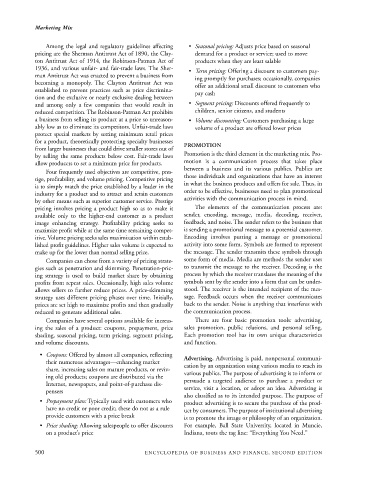Page 523 - Encyclopedia of Business and Finance
P. 523
eobf_M 7/5/06 3:15 PM Page 500
Marketing Mix
Among the legal and regulatory guidelines affecting • Seasonal pricing: Adjusts price based on seasonal
pricing are the Sherman Antitrust Act of 1890, the Clay- demand for a product or service; used to move
ton Antitrust Act of 1914, the Robinson-Patman Act of products when they are least salable
1936, and various unfair- and fair-trade laws. The Sher- • Term pricing: Offering a discount to customers pay-
man Antitrust Act was enacted to prevent a business from ing promptly for purchases; occasionally, companies
becoming a monopoly. The Clayton Antitrust Act was offer an additional small discount to customers who
established to prevent practices such as price discrimina-
pay cash
tion and the exclusive or nearly exclusive dealing between
and among only a few companies that would result in • Segment pricing: Discounts offered frequently to
reduced competition. The Robinson-Patman Act prohibits children, senior citizens, and students
a business from selling its product at a price so unreason- • Volume discounting: Customers purchasing a large
ably low as to eliminate its competitors. Unfair-trade laws volume of a product are offered lower prices
protect special markets by setting minimum retail prices
for a product, theoretically protecting specialty businesses
PROMOTION
from larger businesses that could drive smaller stores out of
by selling the same products below cost. Fair-trade laws Promotion is the third element in the marketing mix. Pro-
allow producers to set a minimum price for products. motion is a communication process that takes place
between a business and its various publics. Publics are
Four frequently used objectives are competitive, pres-
tige, profitability, and volume pricing. Competitive pricing those individuals and organizations that have an interest
is to simply match the price established by a leader in the in what the business produces and offers for sale. Thus, in
order to be effective, businesses need to plan promotional
industry for a product and to attract and retain customers
by other means such as superior customer service. Prestige activities with the communication process in mind.
pricing involves pricing a product high so as to make it The elements of the communication process are:
available only to the higher-end customer as a product sender, encoding, message, media, decoding, receiver,
image enhancing strategy. Profitability pricing seeks to feedback, and noise. The sender refers to the business that
maximize profit while at the same time remaining compet- is sending a promotional message to a potential customer.
itive. Volume pricing seeks sales maximization within estab- Encoding involves putting a message or promotional
lished profit guidelines. Higher sales volume is expected to activity into some form. Symbols are formed to represent
make up for the lower than normal selling price. the message. The sender transmits these symbols through
Companies can chose from a variety of pricing strate- some form of media. Media are methods the sender uses
gies such as penetration and skimming. Penetration-pric- to transmit the message to the receiver. Decoding is the
ing strategy is used to build market share by obtaining process by which the receiver translates the meaning of the
profits from repeat sales. Occasionally, high sales volume symbols sent by the sender into a form that can be under-
allows sellers to further reduce prices. A price-skimming stood. The receiver is the intended recipient of the mes-
strategy uses different pricing phases over time. Initially, sage. Feedback occurs when the receiver communicates
prices are set high to maximize profits and then gradually back to the sender. Noise is anything that interferes with
reduced to generate additional sales. the communication process.
Companies have several options available for increas- There are four basic promotion tools: advertising,
ing the sales of a product: coupons, prepayment, price sales promotion, public relations, and personal selling.
shading, seasonal pricing, term pricing, segment pricing, Each promotion tool has its own unique characteristics
and volume discounts. and function.
• Coupons: Offered by almost all companies, reflecting
Advertising. Advertising is paid, nonpersonal communi-
their numerous advantages—enhancing market cation by an organization using various media to reach its
share, increasing sales on mature products, or reviv-
ing old products; coupons are distributed via the various publics. The purpose of advertising is to inform or
Internet, newspapers, and point-of-purchase dis- persuade a targeted audience to purchase a product or
pensers service, visit a location, or adopt an idea. Advertising is
also classified as to its intended purpose. The purpose of
• Prepayment plan: Typically used with customers who product advertising is to secure the purchase of the prod-
have no credit or poor credit; these do not as a rule uct by consumers. The purpose of institutional advertising
provide customers with a price break is to promote the image or philosophy of an organization.
• Price shading: Allowing salespeople to offer discounts For example, Ball State University, located in Muncie,
on a product’s price Indiana, touts the tag line: “Everything You Need.”
500 ENCYCLOPEDIA OF BUSINESS AND FINANCE, SECOND EDITION

